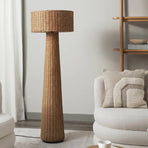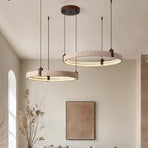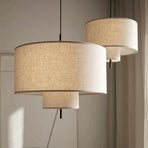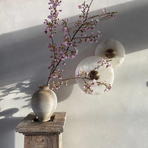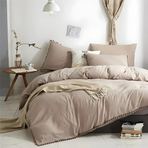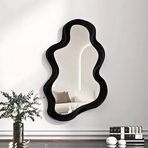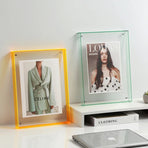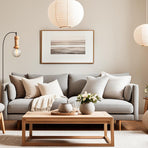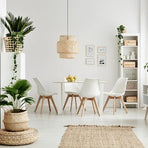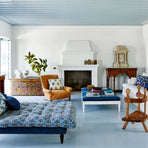There’s a shift happening in bedrooms everywhere. Lighting is no longer just about visibility—it’s about how the space feels. Pendant lights, once reserved for kitchens and dining, are making their way into the bedroom with intention. They don’t just illuminate—they elevate—offering soft, sculptural presence and freeing up surface space.
And in this space where rest isn't a luxury but a necessity, the right bedroom pendant light does more than glow—it grounds.
Welcome to the age of the sculptural pendant: not overhead glare, but suspended serenity. A new wave of bedside pendant lamps is redefining what it means to set the mood, elevate the form, and regulate the nervous system through thoughtful, visual stillness.
Let’s unpack the why—and more importantly, the how. From spatial flow to sensory regulation, the impact of a bedroom pendant light extends far beyond aesthetics. It’s about the materials you choose, the shape you suspend, the height you install, and how all of it makes you feel.
Explore Elenorra’s ceiling lamps collection to discover pieces that do more than light up a room—they help it settle.
The Case for Going Vertical: How Pendants Reshape the Bedside
Rethinking your bedroom lighting starts with reimagining spatial flow. Introducing a pendant isn't about replacing your bedside lamps—it’s about layering in a way that brings height, balance, and intentional design.
When suspended thoughtfully, a pendant draws the eye upward, adding visual lift and freeing your nightstand for the things that matter. In minimalist interiors, where clarity and negative space are key, the impact is especially noticeable—less clutter, more calm. One well-placed fixture with directional lighting can often replace multiple sources of light, simplifying both form and function.
Why Pendants Work in Minimalist Spaces
Minimalist bedrooms thrive on open surfaces and visual stillness. Pendant lighting supports this by removing bulk and lowering the visual noise—no wide lamp bases, no tangled cords, no visual weight on your bedside table. It allows the room to breathe.
Beyond space-saving, pendants introduce verticality. Suspending the light source from above draws the eye upward, creating a sense of elevation even in rooms with modest ceilings. The effect is subtle but architectural—shaping the space without crowding it.
This is where focused designs like the Aiko hanging spotlight come into their own. Compact and sculptural, Aiko delivers task lighting without excess, blending seamlessly into minimalist spaces without interrupting flow. Its purpose is quiet, but deliberate—a guiding light in more ways than one.
Material Matters: Texture Is a Mood
The material of your pendant doesn’t just dictate its look—it shapes how it behaves in the room.
Travertine, marble, glass, wood, and acrylic all interact with light differently. And that interaction has a sensory impact. The Manelli fine pendant lamp, crafted from yellow travertine, disperses warm LED glow in a way that feels grounding and calm—ideal for bedrooms with muted tones or layered textiles.
Marble pendants like the Rainne don’t throw light—they hold it. The result is ambient and atmospheric, more glow than glare. Glass pendants, on the other hand, reflect and expand light. Both the Meera glass pendant light and the Christine pendant lamp work beautifully in rooms that need a bit more light movement—especially when paired with metallic finishes or glossy accents.
Prefer something more natural? The NaturLampa pendant lamp uses slatted wood to soften shadows and warm up the room. It doesn’t overpower. It hums.
How Light Interacts with Material: Glow vs Reflection vs Absorption
Every surface tells light what to do. Some materials bounce it, some cradle it, and others simply soften it into silence. In bedroom lighting, this distinction matters—not just for aesthetics, but for how a space feels at the end of the day.
Reflective materials—like clear glass, polished metal, and glossy acrylic—amplify brightness. They catch and scatter light outward, making a room feel more open, more active. These are ideal for spaces that need a visual lift or for those who prefer a crisp, contemporary vibe. Pendants with glass globes or metallic finishes offer sparkle without harshness, especially when paired with warm-coloured bulbs.
On the other end of the spectrum, absorptive materials—like travertine, marble, slatted wood, or frosted acrylic—hold light closer. Instead of projecting outward, the glow becomes internalised, diffused, and mellow. This creates a hushed atmosphere, where illumination feels more like a suggestion than a spotlight. In sensory terms, it’s the lighting equivalent of a weighted blanket: steady, calm, grounding.
These tactile cues aren’t just visual—they register on a deeper level. When your nervous system reads soft light, it mirrors the softness internally. Lower stimulation, slower breathing, deeper rest. So when choosing a pendant, consider not just the shape—but the surface. The right material doesn’t just glow. It regulates.
Sculptural Light as Spatial Framing
More than a glow, pendant lights offer shape. They frame the bedside zone with quiet intention, becoming part of the room’s architecture.
The Christine pendant lamp, with its geometric opal-and-brass silhouette, becomes a visual anchor above a bedside table. In rooms with symmetry or minimal styling, it adds movement and contour—like jewellery for the ceiling.
The Larabelle pendant lamp, with pleated glass in warm tones, blends softness with structure. Its Nordic silhouette suits bedrooms with layered neutrals or wood tones. Meanwhile, NaturLampa pendant lamp, handcrafted from solid wood, is all about rhythm. It plays well in Japandi or wabi-sabi spaces, where restraint meets warmth.
This is how sculptural lighting works—it doesn’t shout. It defines.
Designing the Bedside Zone with Shape and Silhouette
The area around your bed isn’t just for practical light—it’s a design zone that deserves composition and contour. Just as a headboard frames the sleeping space, pendant lights offer vertical balance and visual punctuation.
Think of proportion first. A pendant that’s too wide for your bedside table can overwhelm, while one that’s too narrow might get lost. As a rule of thumb, pendants should span about one-third the width of your nightstand, or visually sit within the outer thirds of the bed’s width when hung as a pair. This keeps the silhouette balanced and helps anchor the zone without crowding it.
Shapes matter too. Circular pendants introduce softness—perfect if your bed frame or decor leans toward curves, plush upholstery, or relaxed linen. More vertical or elongated pendants bring height and draw the eye upward, adding drama to lower-profile beds. Layered designs with visible joints or tiered materials can echo the folds of bedding or create contrast with sleek, minimal frames.
This isn’t about ornament. It’s about geometry that calms the eye and frames the bed as the sanctuary it is.
Temperature and Tone: The Quiet Science of Rest
Bedrooms aren’t just for sleep. They’re for decompressing, regulating, and easing out of stimulation. And light plays a huge role in that process.
Bright white or cool-toned light can keep the brain alert long after the to-do list is done. That’s why pendants with dimmable or warm-colour capabilities are essential in the bedroom.
The Cory acrylic pendant light offers warm, cool, and 3-colour switching options—so you can shift from clarity to calm without swapping bulbs. Similarly, materials like travertine and frosted glass naturally mellow the LED output, as seen in Manelli and Larabelle.
Warm light helps signal melatonin production, grounding you in a state of rest—not just darkness.
Customisation and Functionality: What Features Matter Most?
In a space that asks so much of its lighting—from reading to resting—practicality becomes part of the design brief.
Dimmable Lighting, Adjustable Height, and Beyond
Good lighting is personal. What works for a Sunday lie-in might feel harsh during midnight wakeups. That’s why customisable features matter.
Dimmable functionality allows you to fine-tune brightness depending on your mood, time of day, or even who’s in the room. It’s especially helpful for couples with different sleep patterns—or for those who want to shift from task lighting to ambient calm without changing fixtures. Pieces like the Cory Acrylic Pendant Light offer this adaptability with 3-colour switching that moves from cool clarity to warm glow effortlessly.
Height adjustment is equally important. Whether you have tall ceilings or low-hung beams, being able to control drop length ensures your pendant feels intentional, not awkward. Hanging too high? You lose intimacy. Too low? You risk visual clutter. Adjustable cords or rods let you dial in the drop, creating symmetry and scale that match your room’s layout—not just a rulebook.
Other features, like interchangeable bulbs, modular design, or multiple head options, make pendant lighting even more versatile. Because lighting, like your bedroom, should evolve with how you live—not just how it looks.
Balance or Contrast: Styling Beyond Symmetry
You don’t have to hang two pendants to get it right.
Yes, symmetry on either side of the bed can bring structure and calm—especially when using lights like the Serena suspension pendant lamp, which comes in two size options for precise pairing. But visual balance doesn’t always mean mirror images.
Drop Rainne on one side and let the other side breathe. Or create contrast with a pendant on one side and a sculptural lamp on the other. The Meera glass pendant light works especially well in this kind of setup—offering both brightness and sophistication without demanding a twin.
Most bedrooms benefit from a drop height of 40–50cm above the bedside table, but the key is proportion. Let the space, furniture, and light fixture guide your placement.
Light That Feels Like Your Bedroom
There’s no universal rule for bedroom lighting. There are only cues—mood, texture, proportion, tone. The right pendant will echo your bedroom’s style without overpowering it.
If your palette leans warm and organic, travertine and wood (like Manelli and NaturLampa pendant lamp) will feel like an extension of the space. Going graphic and minimal? The crisp lines of Serena or the compact profile of Aiko will sit neatly in the visual story. Want softness with just a little sculptural flair? Christine or Larabelle might be your answer.
These aren’t just modern lamps for bedroom styling—they’re a design language. They help your space speak clearly. Calmly. Beautifully.
Bringing It All Together: How to Choose the Right Pendant for You
With so many options, styles, and materials to choose from, making the right decision can feel…a bit much. But it doesn’t have to be. Start with intention—not aesthetics.
Start with Mood, Not Just Aesthetics
Think beyond colour and finish. Ask: How do I want this space to feel? Calm and earthy? Choose materials like travertine, wood, or brushed stone. Crisp and minimalist? Opt for structured glass, metal, or geometric silhouettes. Your emotional intention should lead the way—your pendant is not just visual; it’s atmospheric.
Measure Your Drop, Not Just Your Style
A pendant that’s beautiful in the catalogue might feel awkward if it’s hung too low or high. Measure from the top of your bedside table and aim for a drop height of 40–50cm. But don’t stop there—consider the visual height of your bedhead, any wall art, and how the pendant will relate to those vertical markers. Proportion is everything.
Mix, Don’t Match: Creating Visual Harmony
Matching isn’t always the answer. Especially in design-led bedrooms, contrast and asymmetry can be more powerful. A pendant on one side and a sculptural lamp on the other? Editorial. Two different materials in similar forms? Layered and textured. The trick is cohesion—matching tone, not twin sets.
Your bedroom is already saying something. The right pendant simply helps it say it better.
Final Thoughts: Light That Holds You, Not Just the Room
The best bedroom pendant light doesn’t compete for attention—it sets the tone. It complements the way your room feels in the morning light and the way it helps you unwind at night. It gives shape to silence, and form to the atmosphere. Whether it’s sculptural wood, frosted glass, marble, or travertine, your lighting doesn’t just hang—it holds. So go ahead and explore beyond the basics. Whether you're working with symmetry or contrast, small space or high ceilings, Elenorra’s pendant collection is designed to help your bedroom glow—softly, intelligently, and with presence. Explore Elenorra’s ceiling lamps collection to find lighting that does more than illuminate—it anchors.
Frequently Asked Questions
-
What height should I hang bedroom pendant lights above the bedside table?
A good general rule is to position your pendant about 40–50cm above the top of your bedside table. This keeps the light close enough for reading or ambient glow, without obstructing sightlines or feeling intrusive. For rooms with higher ceilings, consider a longer drop—but let your furniture height and ceiling proportion guide the final decision. -
Can pendant lights fully replace bedside lamps?
They can—but they don’t have to. Bedside pendant lamps are perfect for minimalist bedrooms where surface space is limited, but they also work beautifully when layered with other sources like sconces or table lamps. It’s less about replacing and more about rebalancing the way light functions in your space. -
Are pendant lights suitable for small bedrooms?
Absolutely. In fact, they’re often a better choice. Because bedroom pendant lights hang from the ceiling, they reduce surface clutter and make small rooms feel taller. Opt for styles with a smaller footprint or warm, diffuse lighting to keep the look calm and unobtrusive. -
What bulb temperature is best for bedrooms?
Look for warm white bulbs between 2200K–3000K. This range supports melatonin production and signals the body to wind down. Many modern lamps for the bedroom use dimmable LEDs or allow colour temperature adjustments so you can fine-tune your lighting depending on time of day. -
Can pendant lights be dimmable?
Yes—many bedside ceiling lights are dimmable, either through the bulb itself, a wall dimmer, or remote settings. This feature is especially useful in bedrooms, where soft gradients of light help support rest and sensory calm. -
Should I choose one pendant or two?
It depends on how you want your bedroom to feel. Two pendants on either side of the bed bring symmetry and structure—especially in larger rooms or with a shared bed. A single pendant, on the other hand, can feel more sculptural and editorial. Both approaches work. The key is proportion, not perfection. -
What materials work best for pendant lighting in bedrooms?
Materials influence both the look and the light. Glass and metal reflect and brighten; stone and wood absorb and soften. If your room needs glow and lift, go glass. If you're after warmth and grounding, try travertine, marble, or slatted wood. Each material shapes not just aesthetics—but atmosphere. -
How do I pair pendant lights with my bedroom style?
Use your palette and textures as your guide. Minimalist rooms work well with clean lines and cool metals. Organic or Japandi interiors respond beautifully to natural finishes like wood or travertine. Layered or romantic spaces can benefit from frosted glass or curved forms. Your pendant should echo the energy of the room—not overpower it.

